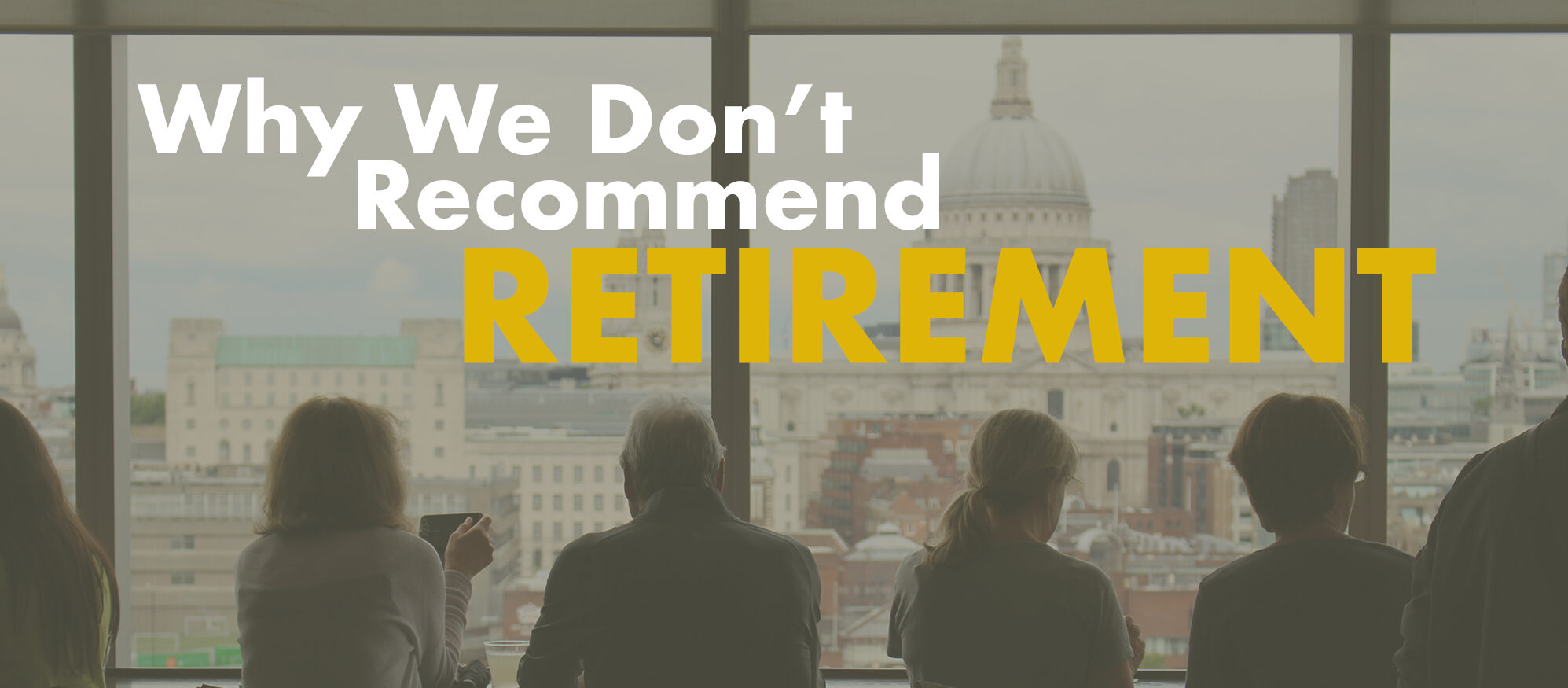Why we don’t recommend retirement

Many of us have a fairytale picture of retirement. No more work! A life of leisure! But here’s a startling statistic: in spite of their newfound freedom, retirees spend an average of two thirds of their leisure time watching television. Eight hours — that’s the equivalent of a workday, just spent in front of a screen. Very few people retire because they can’t wait to watch more TV. But without intentionality, it can quickly become retirement reality.
This statistic offers a glimpse into why the traditional retirement model no longer works and can end up unfulfilling. Traditional retirement represents an escape. Escaping the 9-to-5, getting away from the daily grind, leaving a career and kissing work goodbye. Traditional retirement savings strategies also focus on that escape model: work as long as you can, save and invest as much as you can, then retire when you’ve accumulated enough to fund your leisure.
The problem? There is so much focus on saving for retirement that, when it finally arrives, we have no idea how to spend our retirement. No longer is there a one-size-fits-all model. It’s time to reframe the season of life we used to call retirement.
The changing retirement model
Why the shift? First, we have our good health to thank. Life expectancy is now at a record high. As we’re living longer, we’re staying healthier too. Also contributing to the changing model: more of us are watching our own parents experience a meaningless retirement. Many Baby Boomers in particular have seen their parents’ quality of life decline, even though that life is being extended across a longer span.
Finally, full-time leisure simply is not that glamorous. A growing body of research suggests that retirement is actually boring for many! Fewer and fewer of us explicitly want a life of complete leisure and no work — and more and more of us seek a retirement where we continue to build our legacy.
Retirement, redefined
I find it ironic that the word retirement is actually derived from an Old French word meaning “to retreat.” Society has taught us to work hard to reach a point in our careers with more resources, relationships, influence and perspective than ever . . . then beat a hasty retreat from it all. Retiring away from something, without defining a purpose, can bring about a quick decline in quality of life.
At Sound Stewardship, we recommend a retirement paradigm shift. Rather than retiring AWAY from something, our aim is for people to retire TOWARD something meaningful. Therefore, instead of the term “retirement,” we prefer “repurposement.” And determining what you want your retirement to look like is step one in designing the right savings strategy.
How to spend your retirement
So it’s important to retire towards something meaningful — but what? Only you can define your ideal retirement. But to help start the conversation, we recommend examining your retirement in four key areas, captured in the acronym “L.I.F.E.”:
- L — LABOR: Switching to part-time work, whether earning income or exclusively volunteerism, might mean you can do more physical labor. This can include volunteering at a thrift shop, working retail, serving meals at a soup kitchen, building homes with Habitat for Humanity or working hands-on with a church missions team.
- I — INFLUENCE: Leverage the relationships you’ve worked hard to build. You might advocate for a cause close to your heart, mentor young professionals who are launching careers or use your connections as a consultant or advisor.
- F — FINANCES: This includes traditional philanthropy, like writing checks to meaningful organizations. Beyond a charitable transaction, you might consider getting further invested in an organization on the receiving end of your gifts.
- E — EXPERTISE: Put the skills you used in your job into play for a different organization. Some people might do freelance work in their same field. Others might use their expertise in a volunteer capacity, like a lawyer practicing pro bono for a nonprofit.
What are you good at? What brings you joy? What do you want to be remembered for? Answering these questions can help you conceptualize your own “repurposement.”
How to structure your retirement
Not only is the goal of retirement changing, the structure is changing too. And, just like how you spend your retirement, how you structure it is a personal choice.
The traditional retirement model has three distinct stages: train until your early 20s, work until mid-60s and then begin retirement. For those who have enough saved, adjust the timeline a bit: work until your mid-50s and begin retirement at that time.
Many are now examining a semi-retirement model. This style of retirement adjusts not only the timeline, but also the way you spend that time. Train until your early 20s, work until your mid-50s — then semi-retire, with time split between part-time work and part-time leisure. Workload decreases more gradually as you age, allowing for a more gradual transition.
This approach isn’t necessarily for everyone. It may take larger retirement savings earlier in life to allow for decreasing income early. And some careers don’t flex much on time requirements at late stages.
What age exactly is right for your own retirement? Not everyone has the financial resources to semi-retire in their 50s. And many people reach their mid-50s and still feel a strong desire to work full-time. Everyone has a different path that is right for them.
Completing the retirement equation
Your goals for repurposement, combined with your goals in how to structure it, directly influence how you’ll save for your retirement. A unique and personal retirement calls for unique and personal savings strategies.
If you’re looking for sound advice on planning for your own season of repurposement, we’re here to help. We can guide you in creating the right retirement strategy for you. Contact us to begin the conversation.
< Back to Updates

